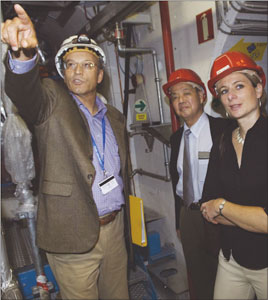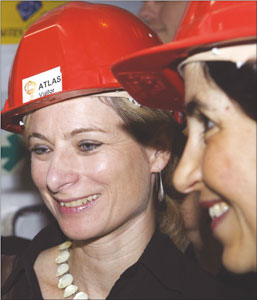Antonella Del Rosso speaks to straight-talking physicist Lisa Randall
Lisa Randall is the first female tenured theoretical physicist at Harvard University. This alone would probably be enough to raise the interest of most science journalists who are all too often confronted with the endless search for a female face who would look good in their newspapers, and make science somehow more human to non-scientific readers. Search her name in Google and read articles about her, then read her most recent book, and you realize that she is also one of the small band of physicists who can write popular science books. Then meet her, as I did at CERN, and you discover a no-nonsense person who finds it “normal” to deal with extra-dimensions and parallel universes, as well as hidden gravitons and quantum gravity.
Randall has visited CERN many times, staying for several months in 1992 to 1993, when she worked on B physics and also on ideas in supersymmetry and supersymmetry breaking. These ideas have since evolved, and she is now one of the world’s experts in the theory of extra dimensions, one of the solutions proposed for the puzzling question of quantum gravity. According to these theories, our universe could have extra dimensions beyond the four that we experience – three of space and one of time.

The idea of an extra dimension is simple to state, but how can we picture extra dimensions in our three-dimensional minds? As Randall concedes, explaining the extra dimensions is possible primarily through analogies, such as, Edwin Abbot’s analogy of Flatland. If you lived on a two-dimensional surface and could see only two dimensions, what would a three-dimensional object become for you? “In order to answer, you would have to explore your object in your two-dimensional view,” she explains. “The slice would be two dimensional but the object would still be three dimensional.” This is to say that, although extra dimensions are difficult to imagine in our limited three-dimensional world, we can nevertheless explore them.
Warping in a universe with extra dimensions would be an amazing discovery, but does Randall expect to find any evidence? The LHC, she explains, could hold the key. “The LHC will allow us to explore an energy scale never reached before – the TeV scale. We know there are questions about this particular scale. We know the simple Higgs theory is incomplete, so there should be something else around. That’s why people think it should be supersymmetry or extra dimensions, something just explaining why the Higgs boson is as light as it is,” she explains. Randall works in particular on the idea of warped geometry. If this is true, experiments at the LHC should see particles that travel in extra dimensions, the mass of which is around the tera-electron-volt scale that the LHC is studying.
One fascinating area of modern physics linked to extra dimensions is that of quantum gravity. Gravity is the best known among the forces that we experience every day, yet there is no theory that can describe it at the quantum level. Gravity also still holds secrets experimentally, because its force-carrying particle, the graviton, remains hidden from view, but Randall’s theories of extra dimensions could shed light here, too.
Could the graviton be found in the additional dimensions, and therefore in the proton–proton collisions at the LHC? “We don’t know for sure,” says Randall, “but the Kaluza–Klein partner of the graviton – the partner of the graviton that travels in extra dimensions – might be accessible.” It seems that even for the theorists leading the field, the theory is a little tricky to understand. “You have one graviton that doesn’t have any mass,” she explains, “and it acts just as a graviton is supposed to act in four dimensions. And you have another graviton that has momentum in the extra dimensions: it will look like a massive graviton according to four-dimensional physics. The particle will have momentum in the fifth dimension and this is the part that we will be able to see.”

The quantum effects of gravity have also led theorists to talk of the possibility that black holes could be formed at the LHC, but Randall remains sceptical. “I don’t really think we will find black holes at the LHC,” she says. “I think you’d have to get to even higher energy.” It is more likely in her opinion that experiments will see signs of quantum gravity emerging from a low-energy quantum gravity scale in higher dimensions. However, she admits: “If we really were able to have enough energy to see a black hole, it would be exciting. A black hole that you could study would be very interesting.”
Interesting, indeed, but also scary, because black holes have always been described as “matter-eaters”. However, there is nothing to fear. Massive black holes can only be created in the universe by the collapse of massive stars. These contain enormous amounts of gravitational energy, which pull in surrounding matter. Given the collision energy at the LHC, only microscopic and rapidly evaporating black holes can be produced in the collisions. Even if this does occur, the black holes will not be harmful: cosmic rays with energies much higher than at the LHC would already have produced many more black holes in their collisions with Earth and other astrophysical objects. The state of our universe is therefore the most powerful proof that there will be no danger from these high-energy collisions, which occur continuously on Earth.
So much for black holes, but I am still full of curiosity about Randall. What, for example, originally sparked her interest in physics? “I actually liked math first more than physics,” she says, “because when I was younger that is what you got introduced to first. I loved applying math a little bit more to the real world – at least what I hope is the real world.” Now, as a leading woman in a male-dominated research field, and as the author of a popular book, Warped Passages, she is the focus of media attention. She finds some of this surprising but notes that it’s not just attention to her but to the field in general. One of the motivations she had for writing her book, was that people are excited about the LHC. She saw the chance to give them the opportunity to find out more about what it will do. “These are difficult concepts to express. You could give an easy explanation or you could try to do it more carefully in a book. One of the very rewarding things is that a lot of people who have read my book have said they can’t wait for the LHC; they can’t wait to see what they are going to find. So it is exciting when you give a lecture and thousands of people are there – it’s exciting because you know that so many people are interested.” On the other hand, she finds some of the specific types of reporting disturbing, because it shows how far society still has to go: “We haven’t reached the point where it’s usual for women to be in the field.”
In addition to her work on black holes, gravity and so on, Randall is currently working on ideas of how to look for different models at the LHC, and how to look for heavier objects, such as the graviton, that might decay into energetic top quarks. She is also trying to explore alternative theories. “I’m not sure how far we’ll go in things like supersymmetry,” she says, “I’m playing around with models and ways to search for it at the LHC.”
Yes, physics is about playing around with ideas – ideas that nobody has ever had before but that have to be tested experimentally. The LHC will shed light on some of the current mysteries, and Randall, who like many others has played around with ideas for years, can’t wait for this machine to produce the experimental answers.
• For Lisa Randall’s lectures at CERN in March 2008 on “Warped Extra-Dimensional Opportunities and Signatures”, see http://indico.cern.ch/conferenceDisplay.py?confId=28978, http://indico.cern.ch/conferenceDisplay.py?confId=28979 and http://indico.cern.ch/conferenceDisplay.py?confId=28980.





